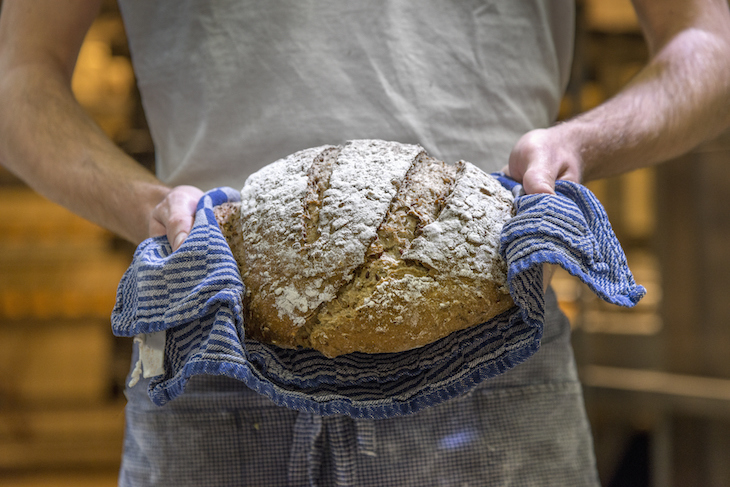This ought to be the perfect time for a rant about how we’ve reached peak sourdough. It’s been all the rage for three or four years now and, really, someone needs to take a stand. As annoyingly overrated foodstuffs go, it’s up there with kimchi and goji berries and organic chia seeds: obsessively prepared by people with far too much beard, raved about in the Guardian and especially big in that epicentre of global communism, San Francisco. And it doesn’t even taste like bread — more like Mongolian yak’s yoghurt.
Problem is, I can’t. Because, like Donald Sutherland at the end of Invasion of the Body Snatchers, I’ve been got. It began when the Fawn passed me this photocopy of a recipe, together with a jar with a white-ish substance at the bottom smelling faintly rancid. They had been sent as a gift by a colleague who’d got the sourdough religion and wanted to spread the word. ‘Oh God, must I really?’ I muttered as I pored over the complicated details.
But that was nine months ago and since then I’ve got it bad. At first you think it’s going to be just a fun experiment: ‘I’ve never tried making bread before, so isn’t it brave and clever of me to start with just about the hardest type there is? And won’t my friends and family be impressed when they taste the fruits of my labour?’ Only a few weeks in do you realise that the person who sent you the stuff in the jar — your ‘starter’, as it’s known — might just as well have given you a wrap of heroin. Once you’ve entered the rabbit hole, the only way you can go is deeper.
To start with, I tried the most basic recipe. One so simple and undemanding you didn’t even have to knead the dough: you just had to mix it for no more than 30 seconds. When you do this, the result isn’t at all bad: much tastier than a bog-standard loaf of unsliced white. But still, it gets you wondering: ‘How much more amazing might it be if I did it properly?’
This was the point at which I graduated from the photocopied quick recipe to a more advanced one from the Bath-based sourdough expert Richard Bertinet. Suddenly, my original lovingly cared-for ‘starter’, which I kept in the fridge in a pot topped with muslin so it could breathe and which I fed with fresh flour and water every few days, was no longer enough. Now, I had to prepare something called a ‘ferment’. This looks like a solid lump of dough, but when you break it open after a few days it smells faintly alcoholic and is full of holes as if infested with white worm. When it has reached the right point of yeastiness, you’re ready to go … through a laborious process that now takes half a day rather than your original half an hour.
Once you’ve broken off bits of ferment and mixed them with your flour and water, you have to work it for about 20 minutes by stretching it repeatedly upwards and then allowing it to collapse like a breaking wave. Initially it’s very claggy and on the first few attempts it gets stuck to your fingers. After a time, though, you develop a lightness of touch, and you begin to appreciate the subtly changing texture of the dough — as well as the weird masochistic buzz of going for nearly a whole half-hour in which you are quite unable to check your iPhone.
That’s because your fingers are coated with a floury paste which befouls everything you touch and is a nightmare to get off. You can’t just rinse it off in the sink because your drain soon gets blocked. So instead you have to go through a process almost as laborious as the breadmaking: standing over a bin and rubbing your hands together till the flour achieves a bogey-like consistency and rolls off in little gobbets. Then you’ve got all the equipment to clean — the bowls, your marble work surface — which you can’t just leave for the washing-up fairies, as you’d prefer, because it pisses off your wife.
Obviously, sourdough breadmaking isn’t solely a male pursuit. But I do suspect there’s something in it that is particularly appealing to the male psyche: the obsessive attention to detail; the endless permutations of batch variation; the quest for perfection which you know can never truly be achieved; the specialist kit.
You might think, as I initially did, that you can make sourdough with what you’ve already got. Wrong! At the most basic level, you need a banneton — the wicker basket in which you leave your bread to prove for about 15 hours — and your dough scraper and a lame (a curved razor blade) to slash the criss-cross pattern on the top. But once you’re down the rabbit hole, a whole vista of complex new tunnels opens up, as I discovered when I visited a fellow sourdough victim, Celestria.
Up till then, I’d thought I was a bit of an expert. I’d reached the stage where I was offering friends advice and giving them pots of starter to take home with them. But when I saw Celestria’s recent bakes, I suddenly felt a total amateur. Where my bread still looks a bit like thick cowpats, hers were fully risen and as handsomely artisanal as something you might get from a bijou bakery in San Francisco.
Which, inevitably, was where she’d got her recipe, about ten times more complicated than mine and requiring a digital thermometer so you can work the dough at the right temperature, and also an expensive cast-iron Dutch oven that you put inside your electric oven in order to give the bread that secondary rise known as ‘oven spring’. Sad, isn’t it?
Got something to add? Join the discussion and comment below.
Get 10 issues for just $10
Subscribe to The Spectator Australia today for the next 10 magazine issues, plus full online access, for just $10.
You might disagree with half of it, but you’ll enjoy reading all of it. Try your first month for free, then just $2 a week for the remainder of your first year.















Comments
Don't miss out
Join the conversation with other Spectator Australia readers. Subscribe to leave a comment.
SUBSCRIBEAlready a subscriber? Log in